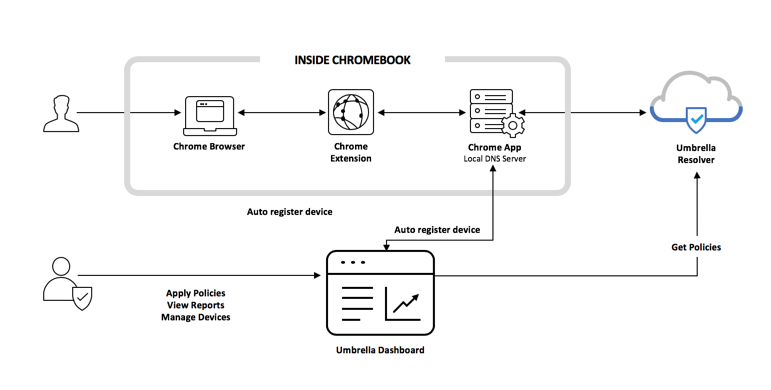Get Started with Umbrella Chromebook Client
The Cisco Umbrella Chromebook client provides DNS layer protection for Chromebook users. To enable DNS-layer protection, deploy the Umbrella Chromebook client. Once deployed, the Umbrella Chromebook client lists your Chromebook users as Umbrella identities and immediately protects the Chromebook users by the default DNS policy.
For more information about how to deploy the Chromebook client, see Deploy the Chromebook Client.
Umbrella's Policies
Policies are the heart of Umbrella and define how security and access controls are applied to identities. A policy provides DNS-layer visibility, security, and enforcement with the ability to selectively proxy risky domains for added security. For more information about Umbrella policies, see Manage Policies.
Umbrella Chromebook Client Use Cases
You can use the Umbrella Chromebook client to protect against phishing attempts, filter internet destinations by content categories, and provide visibility into user endpoints on networks.
- Protection from phishing — Protect against phishing threats with Umbrella’s global network data and predictive intelligence. Discover discover internet infrastructure used to host phishing sites—before employees or students ever receive the phishing email.
- Content category filtering — Gain visibility and control of content on and off network. Organizations can help ensure compliance with the Children’s Internet Protection Act (CIPA) utilizing over 80 content categories, as well as their own allow and block lists of domains.
- Per-user visibility and policy — Enforce policy-based protection whether users are on or off the network. If a user's endpoint becomes infected, pinpoint activity to a specific user to expedite remediation.
Note: The Umbrella Chromebook client operates as a Chrome extension and performs filtering of web browser traffic only. The Umbrella Chromebook client does not filter DNS traffic from non-browser apps.
How the Umbrella Chromebook Client Works
- A user enters a URL in the Chromebook browser.
- The Chromebook client extension copies the domain name from the URL and sends it to the Chromebook client app.
- The app creates an Extension Mechanisms for DNS (EDNS) query, then sends the DNS request, including the EDNS information, to Umbrella.
- Depending on the applicable Umbrella policy, the resolver responds by either blocking or allowing the requested destination.

Get Started with Umbrella Chromebook Client > Umbrella Chromebook Client Prerequisites
Updated almost 2 years ago
